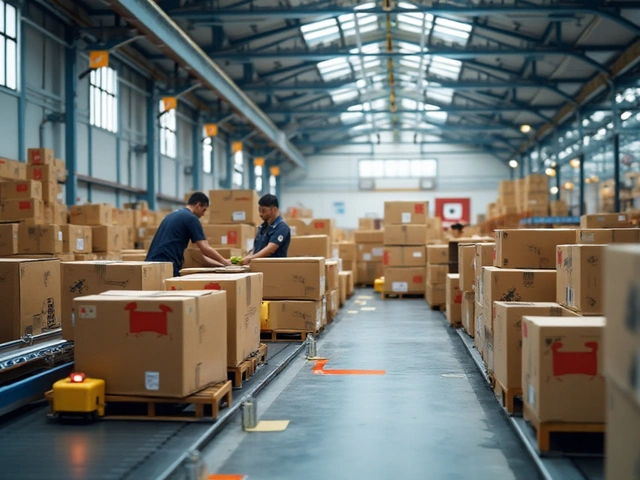If you’ve ever wondered who’s making the big calls in a logistics company, you’re not alone. Most people hear “logistics” and think of truck drivers and warehouse teams, but someone sits at the top, calling the shots for those operations. That person is usually the Chief Logistics Officer, or sometimes called VP of Logistics in larger firms. This role is all about strategy, troubleshooting, and making sure stuff moves smoothly from point A to B—no matter what curveballs happen along the way.
This isn’t just about pushing paper. The top logistics boss decides which new tech to invest in, which partners the company should trust, and how to save millions on shipping costs. They’re the ones who have to keep goods flowing even if there’s a sudden border shutdown or a container ship gets stuck (remember the Suez Canal mess?). So, if you’re picturing some suit far removed from the action—you couldn’t be more wrong. The best leaders in logistics have been in the trenches and know the pain points firsthand.
- Climbing the Logistics Ladder
- What a Chief Logistics Officer Actually Does
- Pathways to the Top Job
- Tips for Aspiring Logistics Leaders
Climbing the Logistics Ladder
People don’t just wake up one day as the Chief Logistics Officer. Getting to the logistics top spot usually takes years of hard work, good timing, and some luck. Most start at entry-level gigs: warehouse associate, dispatcher, or logistics coordinator. Here you’re learning the basics, like how inventory works and why timing is everything. It’s honestly the best bootcamp you could ask for in this business.
Next up, folks move into management roles—think supervisors and operations managers. This is when you start juggling bigger problems, like sorting out staff schedules or fixing delivery delays. Many companies look for people who can keep costs down and customers happy. If you’re a quick thinker and can stay calm when a truckload of goods goes missing, you're already miles ahead.
After a few years, high performers get tapped for director titles: Director of Transportation, Warehouse Manager, or Supply Chain Director. Stats in the field say it takes around 10–15 years for most people to reach a senior director post. You’ll need to prove you can handle budget planning, major negotiations, and tech upgrades—sometimes all at once. A lot of companies also love people with bachelor’s or master’s degrees in supply chain management, but plenty at the top have worked their way up from the warehouse floor.
What makes someone stand out? Two things: learning how to solve problems fast, and not being afraid of changing how things are done. If you can show you saved money, sped up deliveries, or cut out waste, people will notice. Promotions in logistics aren’t always about how many people you manage—they’re about the problems you fix and the results you deliver.
- Entry-level logistics jobs: warehouse worker, dispatcher, inventory clerk
- First supervisory step: team lead or warehouse supervisor
- Middle management: operations manager, transportation manager
- Senior roles: logistics director, supply chain director, VP, or Chief Logistics Officer
If you want to get to the very top, it helps to stay curious. New technology, like AI route mapping or robotic picking, is changing things fast. The people moving up the ladder keep learning those tools and aren’t scared to pitch wild ideas in meetings.
What a Chief Logistics Officer Actually Does
The Chief Logistics Officer (CLO) is basically the quarterback of a logistics company. Every day, they make high-stakes decisions on how things are shipped, stored, and delivered. Their job covers a lot of ground, often more than most people realize.
For starters, they’re in charge of designing the big-picture logistics game plan. That means setting up supply chain strategies to cut delays, save on costs, and keep customers happy. A CLO decides which technologies to use—think real-time tracking, warehouse automation, or data tools that predict where problems will hit before they happen. Companies like FedEx and Maersk depend on this kind of leadership to stay competitive.
Managing risk is a huge part of the role. If a big snowstorm is threatening to shut down warehouses in Chicago, or there’s a shortage of truck drivers on the West Coast, the CLO’s phone is ringing nonstop. They’re the ones putting backup plans in motion—rerouting shipments, tapping different partners, or even using air freight in a pinch. When global trade routes get blocked, like what happened with the Suez Canal in 2021, these leaders are the ones steering the scramble to keep products moving.
Here’s what typically lands on their desk:
- Building and leading teams—sometimes thousands of people spread across the world.
- Rolling out tools and software to simplify processes and reduce mistakes.
- Negotiating with big suppliers, transport companies, and warehouse operators.
- Deciding which sustainability moves make sense. Think electric delivery vans or reducing packaging waste.
- Tracking metrics. If costs spike or delays pile up, they know—and act fast to fix it.
Diversity in tasks is the name of the game. One day, the CLO might be strategizing with the finance team about costs; the next, they’re visiting a warehouse to see how robotics are changing workflows. And with more companies pushing for fast, online delivery, CLOs are under constant pressure to innovate. If a company wants to dominate in the logistics industry, this is the key role making it happen. Real talk: being a Chief Logistics Officer isn’t about sitting in meetings all day—it’s about making sure the company never drops the ball, no matter what the world throws at them.

Pathways to the Top Job
Climbing up to the highest spot in a logistics company isn’t luck—it’s a series of moves, learning, and lots of hustle. The strongest route starts with hands-on experience, since most companies look for leaders who’ve seen the chaos of logistics up close. It’s common to begin as a warehouse supervisor, operations analyst, or in transportation planning. From there, your path crisscrosses through mid-level roles like logistics manager or supply chain coordinator, letting you see everything that can go right (or horribly wrong).
Education matters, but only to a point. Most chief logistics officers hold at least a bachelor’s degree in supply chain management, business, or engineering. About 40% of Fortune 500 logistics chiefs have an MBA, based on a 2023 LinkedIn survey. Certifications like the Certified Supply Chain Professional (CSCP) or Six Sigma Black Belt can also push you ahead when resumes are stacked high.
- Start in entry-level positions like inventory clerk, dispatcher, or analyst.
- Get a degree—preferably in logistics, supply chain management, or business.
- Move up to supervising roles, handling budgets, and leading teams.
- Pursue certifications to stand out for specialist or management tracks.
- Take on projects involving big changes, tech rollouts, or problem-solving.
If you aim for the logistics top job, you’ll need to show you can handle everything from tight delivery deadlines to negotiating with stubborn freight carriers. Data skills are huge, too. According to a 2022 Statista report, 72% of logistics VPs said being “data-driven” mattered more than having decades of experience in one company.
| Step | Avg. Years Spent | Key Focus |
|---|---|---|
| Entry-level | 2-4 | Learning basics, building operational skills |
| Mid-management | 4-7 | Team leadership, process improvements |
| Senior roles | 5-10 | Strategy, tech, budget control |
One more tip: network! Most top execs didn’t just sit behind a desk. They met people across companies, joined professional organizations like CSCMP, or even talked to competitors at conferences. Your network can open doors that a killer resume alone can’t.
Tips for Aspiring Logistics Leaders
So, you want to climb your way up to the highest ranks in logistics? The world of logistics companies rewards folks who combine hands-on know-how with a strong grasp of big-picture thinking. Here’s what you need to know if you’re serious about running the show.
First up, let’s talk skills. Nobody gets handed the keys to the supply chain kingdom without rock-solid communication, adaptability, and data smarts. Most Chief Logistics Officers started off either as analysts, warehouse supervisors, or transportation planners—jobs that teach you how goods flow and where things go wrong. Companies look for leaders who’ve been in the thick of it and know why shipments get delayed or how a simple missed scan can cost thousands.
- Logistics is getting more tech-driven by the day. Companies are now using AI to forecast demand and blockchain to track shipments. Get comfortable with tools like SAP, Oracle, or Manhattan Associates.
- Networking matters a ton. Industry conferences like MODEX or CSCMP’s Edge Conference are where people make career-changing connections.
- Consider certifications. Practical ones include the APICS Certified Supply Chain Professional (CSCP) or the Certified in Logistics, Transportation and Distribution (CLTD). They’re respected everywhere.
- Global experience is gold. If you get a chance to run international routes or manage overseas warehouses, take it. The top dogs almost always have cross-border chops.
- Don’t sleep on soft skills. Building teams, handling “crisis mode,” and negotiating with suppliers are daily parts of the job at the top.
If you want to see how others did it, just look at recent data. According to a 2024 survey by Supply Chain Digital, 64% of logistics execs worked in their industry for over 15 years before landing a top role. And nearly 40% moved between companies or countries to get there.
| Certification | Average Salary Increase |
|---|---|
| APICS CSCP | 12% |
| CLTD | 10% |
Last tip: Own your mistakes. Every logistics boss has a story about a nightmare delivery or a busted software rollout. Sharing how you fixed tough situations can make you stand out as a real leader—not just a manager who got lucky.





